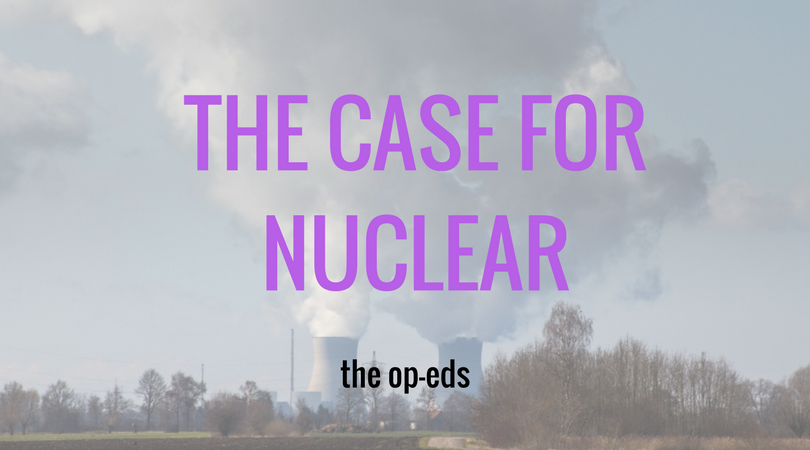Climate change is arguably the largest threat to the American economy and way of life. To maintain and protect both our planet and our lifestyles, the United States must be moving towards carbon-neutral energy sources. While two-thirds American public is actively advocating for cleaner energy sources, government incentives are seemingly disregarding nuclear power[i].
The Op-Eds are my take on some current issue I’ve had on my mind. They are written in a semi-academic fashion, so below, I will link my sources, often both scholarly articles and popular news outlets. Occasionally I’ll leave some additional resources if you’re interested in learning more. These are my own opinions, and I’m interested in hearing yours in the comments below. If you have a topic you’d like me to research and discuss, please contact me!
Currently:
Nuclear plants in the United States are under major economic threat. The 99 nuclear power plants in America are actively being submitted for closure under concerns for public safety and regulatory issues. Many of these plants deemed for closure have had substantial investments in upgrades within the last decade, so they may continue operating at safe and efficient levels. The EPA’s Clean Power Plan, under President Obama (and now currently threatened by President Trump), called the electricity market to make some major changes. While coal is still heavily subsidized, nuclear was essentially blacklisted for increased contributions to the grid. We have functioning, capable nuclear plants that are being closed for unfounded fears, and then also ignored as per a government plan that is not even currently in practice.
Why Nuclear?
Though nuclear is not a renewable energy source, it is carbon-free. While we await funding and infrastructure to move our grid towards a higher percentage of renewables, the American public should acknowledge the existing options for a zero carbon energy source. America has the same amount of nuclear plants today as it did in the 1980s, and nuclear continues to provide about 20% of the energy demanded by a growing population[ii]. Nuclear plants have been invested in to continuously improve efficiency. America does not have a to take a huge leap from coal to move towards a cleaner grid; let’s take advantage of what we have to quickly, smoothly transition into carbon neutrality.
An argument against nuclear power lies in the generation of nuclear waste. Generating nuclear power from uranium results in waste, in the form of radioactive plutonium. However, the amount of waste created by nuclear power is significantly less than the gaseous chemical outputs from coal power plants. The scale of waste is often overlooked simply because nuclear waste is solid, and carbon dioxide is not easily visualized. Radioactive waste is consolidated in tanks and geologically disposed — we have piles of nuclear byproducts in remote areas. Admittedly, the United States has not yet established large underground geological disposal sites. Generally, the tanks are simply watched for years by some military entity to ensure there is no leakage. The threat of a radioactive spill is also often used as a warning against nuclear power — but, there has been no American nuclear spill in almost forty years[iii]. Domestic nuclear threats are fears not supported by any evidence.
While not currently in practice, nuclear power technology could very easily account for all its waste products, being that they are in solid form. While coal has gaseous byproducts, nuclear’s could be simply quantified and their respective environmental damages calculated. The cost of the nuclear energy could more accurately reflect its externalities[iv]. Electricity generated from coal is less reflective of the environmental impacts of the extraction and carbon dioxide output. Even with these embedded costs, nuclear energy is relatively inexpensive compared to other fuel sources (Rastogi). Furthermore, saying any energy source does not have a carbon footprint is somewhat inaccurate; even solar panels and windmills require carbon-intensive manufacturing. It is economically more efficient to continue upgrading and improving nuclear plants, considering embedded energies, than to tear down plants and build renewable infrastructure. Embedded energies are the inherent costs and inputs of already-existing walls, equipment, etc… it is a smarter financial and environmental move to update available resources rather than completely replace.

Nuclear is quickly being viewed as a fuel of the past. We are favoring the expansion of alternative energy sources, and investing heavily in research and development. All the while, coal is still dominating our grid and polluting our planet. It is in America’s best interest to reevaluate how we can move towards a lower-carbon future by simply continuing to improve what we already have. While we long-term absolutely need to shift to a grid of renewable fuel sources, we should be currently advocating for using nuclear over other non-renewable sources.
References
[i] Kennedy, Brian. “Two-Thirds of Americans Give Priority to Developing Alternative Energy over Fossil Fuels.” Pew Research Center, 23 Jan. 2017, www.pewresearch.org/fact-tank/2017/01/23/two-thirds-of-americans-give-priority-to-developing-alternative-energy-over-fossil-fuels/.[ii] Yergin, Daniel. The Quest: Energy, Security and the Remaking of the Modern World. Penguin Books Ltd., 2012. Chapter 20: The Urgency of Fuel Choice
[iii] Rastogi, Nina. “The Environmental Arguments for and against Nuclear Energy.” Slate Magazine, 13 July 2010, www.slate.com/articles/health_and_science/the_green_lantern/2010/07/the_nuclear_option.html.
[iv] Alexander, Lamar, and Sheldon Whitehouse. “Opinion | To Slow Global Warming, We Need Nuclear Power.” The New York Times, The New York Times, 20 Jan. 2018, www.nytimes.com/2016/12/21/opinion/to-slow-global-warming-we-need-nuclear-power.html.
- World Nuclear Association: http://www.world-nuclear.org/information-library/country-profiles/countries-t-z/usa-nuclear-power.aspx
- Fun easy read: Holthaus, Eric. “It’s Time to Go Nuclear in the Fight against Climate Change.” Grist, 12 Jan. 2018, grist.org/article/its-time-to-go-nuclear-in-the-fight-against-climate-change/.
- Also short but goes into more detail about how nuclear actually works on the more technical level:
Johnson, Nathanael. “When Solar and Wind Need a Boost, Nuclear Might Be the Best Option.” Grist, 6 Mar. 2018, grist.org/article/when-solar-and-wind-need-a-boost-nuclear-might-be-the-best-option/.

